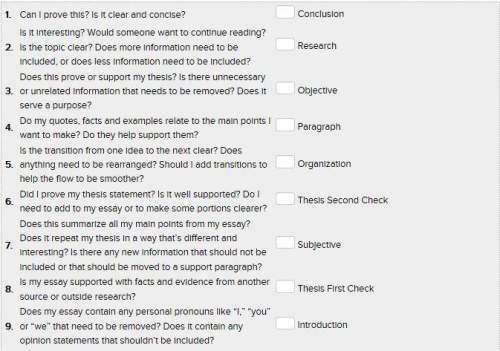1. Objective
Can I prove this? Is it clear and concise?
2. Introduction
Is it interesting? Would someone want to continue reading? Is the topic clear? Does more information need to be included, or does less information need to be included?
3. Paragraph
Does this prove or support my thesis? Is there unnecessary or unrelated information that needs to be removed? Does it serve a purpose?
4. Thesis First Check
Do my quotes, facts and examples relate to the main points I want to make? Do they help support them?
5. Organization
Is the transition from one idea to the next clear? Does anything need to be rearranged? Should I add transitions to help the flow to be smoother?
6. Thesis Second Check
Did I prove my thesis statement? Is it well supported? Do I need to add to my essay or to make some portions clearer?
7. Conclusion
Does this summarize all my main points from my essay? Does it repeat my thesis in a way that’s different and interesting? Is there any new information that should not be included or that should be moved to a support paragraph?
8. Research
Is my essay supported with facts and evidence from another source or outside research?
9. Subjective
Does my essay contain any personal pronouns like “I,” “you” or “we” that need to be removed? Does it contain any opinion statements that shouldn’t be included?
Explanation:
1: Objective: in theses provided the description of methods/techniques you will use to reach at your aim. Objectives also describe what the researcher is trying to achieve. S objectives are what to achieve and how to achieve.
2: Introduction: The general purpose of introduction in a theses is to introduce the reader with the theses. Introduction should include,
i) general topic and some background to the topic/problem.
ii) introduce the current research
3: Paragraph: Each paragraph of the theses should lead you close and closer toward your goal/conclusion. Nothing extra should be there, and nothing required should be out of it.
4: Theses First Check:
You will check that all relevant information is present in the theses, and that no irrelevant facts, figures, calculations are there.
5: Organization
Organization of thesis means how you organize your information. It should be coherent and step by step lead to the conclusion.
6: Thesis Second Check
It is counter checking everything you have presented in your thesis including objective, introduction, paragraphs, organization, clarity and correctness.
7: Conclusion
The conclusion part should clearly conclude all the points, objectives, and information of the thesis.
8: Research
The thesis should also include relevant research which has already been conducted in your thesis’ specific niche.
9: Subjective
Counter check to ensure that your thesis does not have any personal opinions or any other subjectivity. However, you will use first person pronouns such as I, my when explaining any research methodologies and measuring techniques you have chosen.















